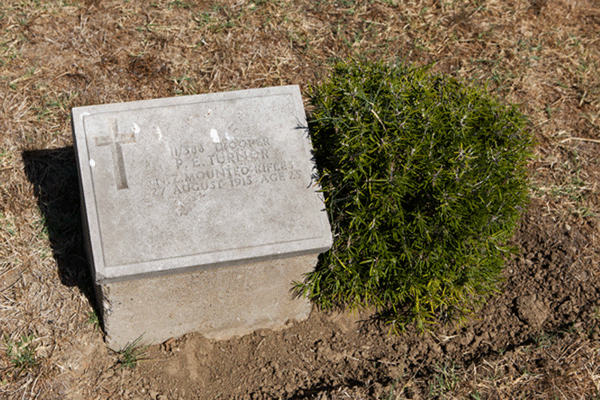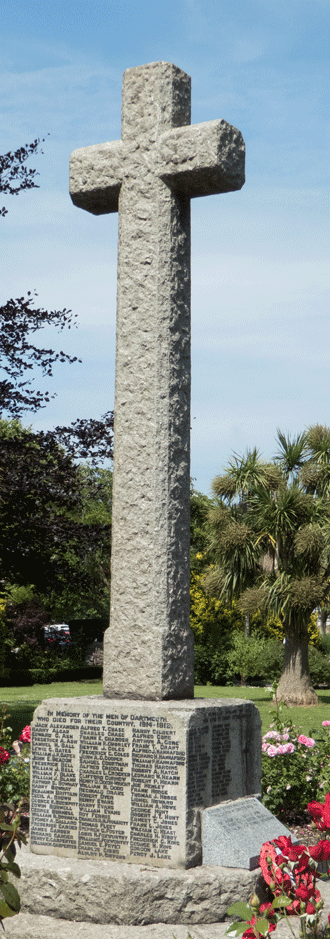Percy Edward Turnor
Percy Edward Turnor was born in Eketahuna, near Wellington, New Zealand. He was not commemorated on public memorials in Dartmouth, but is on our database because his death was announced in the Dartmouth Chronicle. His father, Francis Collison Turnor, was born in Dartmouth, and his uncle, Harry Marsh Turnor, still lived in the town at the time of Percy's death (and indeed until his own death in 1938).
Family
Percy Edward Turnor was born in 1890, most probably on 1st July (his birth was registered between July-September 1890 but the date of birth he gave when joining the Army was 1st July 1889). He was the only son of Francis Collison Turnor and his wife Charlotte Baker.
Francis Collison Turnor was born in Dartmouth on 7th July 1865 and baptised at St Petrox on 9th August the same year. He was the second son of Edward Marsh Turnor and his wife Frances (Fanny) Collison. Edward and Fanny had come to Dartmouth sometime before 1861, when they were recorded in the Census living in Clarence Street. They had married in 1854 in Norfolk, although they both came from London, where Edward worked as a Clerk in a "Colonial Broker's Office". His father, Richard Turnor, was a wine merchant in the City; Fanny came from a prominent family of London merchants, who were major investors in South Africa and traded wine, brandy and other goods from the Cape. Fanny herself was born in Cape Town.
In the 1861 Census Edward described himself as "former merchant". Three of his children were baptised in Dartmouth - Elizabeth (1862), Francis (1865), and Richard (1868) - and there his occupation was given as "gentleman". By 1866 he was living in Bayards Cove, and had been elected a Town Councillor; by the 1871 Census, he was a magistrate.
In 1871, perhaps profiting from Fanny's family connections with South Africa, he became the Shipping Agent for the Cape & Natal Steam Navigation Company, set up that year to take mail, passengers and freight from Dartmouth to the Cape, calling at Madeira and St Helena. When the company failed the following year the service was taken over by Donald Currie & Co, as part of the Castle Line, and continued for the next twenty years, during which Edward remained the Dartmouth agent. In 1874 he moved from Bayards Cove to South Town, buying Derwent Lodge from Francis Simpson. This house remained the family home for many years, passing on Edward's death in 1891 to his eldest son, Harry Marsh Turnor. Harry also seems to have inherited his father's shipping agency business, becoming in 1892 the agent in Dartmouth for the British and Colonial Steam Navigation Co Ltd.
Francis Collison Turnor, however, evidently decided to make his fortune away from Dartmouth. His first job after leaving school was with the shipbrokers and shipowners Scrutton & Sons in London, but life in an office apparently did not suit him. He next tried farming in Kansas, USA, where in 1885, in the Kansas State Census, he was recorded as one of several young men boarding in a house in the township of Eagle, in Sedgwick County. In 1886, however, he was back in England, where he was best man at the wedding of his elder brother Harry to Agnes Michelmore, daughter of Jeffery Michelmore of Berry House, Berry Pomeroy. Later that same year, he emigrated to New Zealand, on the SS Tongariro, and remained there for the rest of his life.
He settled in Eketahuna, north-east of Wellington, in the Wairarapa region. Eketahuna, considered by some today to be the stereotypical rural New Zealand town, was a township developed and built by emigrants from Scandinavia, brought to New Zealand to clear the dense bush, because of their skills in forestry. It was originally called Mellemskov, meaning "heart of the forest". The conditions were demanding and the clearance process was very hard, but by the time Francis arrived there approximately ten years later, the township was thriving.
In partnership with another settler, Francis established a butchering business. In 1888 he married Charlotte ("Lottie") Baker, who had arrived in New Zealand from England five years earlier. They had two children, Gladys Ida Frances, born in 1889, and Percy Edward, born in 1890.
In 1889 Francis leased a 900 acre sheep-farm at WiWaka, two miles south of Eketahuna, which he subsequently bought. He did well, but life was not easy. In 1894, the farm was hit by a serious bush fire, in which he lost 300 sheep - local newspapers reported that "at one time the whole of Eketahuna was in danger, but the efforts of residents saved most of the buildings which caught".
The 1897 "Cyclopedia of New Zealand", describing the principal businesses and people of the town, commented that "in social and athletic circles [Francis] is prominent as a member of the Masterton Masonic Lodge and of the local Lodge of Oddfellows, as president of the Eketahuna Football and Cricket Clubs, of the Eketahuna Minstrel and Dramatic Society, and as one of the vice-presidents of the Wairarapa Rugby Union". Francis became a magistrate in 1897, served as a councillor for many years, and as mayor of the town from 1912-1919 (his wife of course serving as mayoress). The photo below is from the Wairarapa Archive:
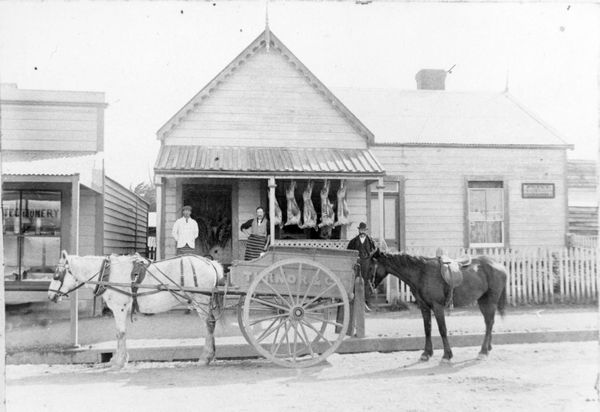
According to the Otago Times, the shop and its contents were destroyed by another bush fire on 18th May 1913, though "the recently installed high-pressure water supply was instrumental in checking a further spread". Francis also lost an empty shop.
Percy was educated at Wellington College, established in the city of Wellington in 1867. He left the school in 1907. The farm, and his father's business interests in Eketahuna, were to be his future, until the war intervened.
Service
The British Empire declared war on Germany on 4th August 1914 and, on the other side of the world, the government of the Dominion of New Zealand was informed just before 1pm on 5th August, New Zealand time. Across the Empire it was left to the parliaments of the individual dominions to decide the extent of their contributions to the war. New Zealand legislators had no doubts about the need to be involved. In addition to their loyalty to Britain and the Empire, New Zealand's prosperity rested on its market in Britain and the need to keep the sea trade routes open. New Zealand offered the British an Expeditionary Force that same day and the offer was accepted soon after.
Countrywide recruiting began two days later and the response was immediate. New Zealand was well prepared to mobilise troops thanks to the 1909 Defence Act, which was intended to provide a Territorial Force of 30,000 men. The act provided for the gradual military training of every male from the age of 14-25, after which he was required to serve in the reserve until the age of 30. Volunteers for overseas service came forward from amongst the territorials and mobilisation and training took place in the four main territorial centres. The Wellington Mounted Rifles, a mounted infantry regiment, was formed from three Territorial Force squadrons:
- Queen Alexandra's 2nd (Wellington West Coast) Mounted Rifles
- 6th (Manawatu) Mounted Rifles
- 9th (Wellington East Coast) Mounted Rifles.
Also volunteering were many who, like Percy, were not members of the Territorial Force. Percy enlisted in the Wellington Mounted Rifles on 13th August, at the neighbouring town of Dannevirke, joining the 9th Squadron. The Mounted Rifles were not cavalry but mounted infantry - the horses were used to move men rapidly from place to place, but, once on the battlefield, the men fought on foot as normal infantry. The Regiment concentrated at the regional mobilisation centre, Awapuni Racecourse, Palmerston North, on 12th August. The full complement of 26 officers and 523 other ranks was reached in only a few days. Only men between 20 and 40 were eligible. Recruits had to be at least 5ft 3ins/162.5 cm tall, weigh 76 kg/168 lbs or less, and be physically fit. Percy was 24 (though he seems to have given his age as 25); 5ft 10ins tall; and weighed 160 lbs. His attestation form also recorded a "fair complexion", blue eyes and fair hair. He was pronounced physically fit.
The next few weeks until late September were spent in equipping troops, selecting horses, and carrying out initial training. According to Percy's military records, he "embarked on active service" on 23rd September 1914. The regiment formed part of the "Main Body" (plus the 1st Reinforcements) of the Expeditionary Force, the largest single group of New Zealanders ever to leave the islands. Major civic events were organised to mark the departure. Up to 30,000 people attended Wellington's farewell at Newtown Park on 24th September, when schools and many businesses closed for the day.
At the last moment, however, the departure was delayed. The New Zealand Prime Minister, William Massey, was concerned about the vulnerability of the convoys to attack from the German East Asia Squadron, under Admiral von Spee (see our article on The Battle of Coronel) so more powerful escorts were brought in. Finally, about 8,500 men, and nearly 4,000 horses, sailed from Wellington on 16th October 1914.
Percy was on the Orari, Transport Number 6, a steamship owned by the New Zealand Shipping Co Ltd. On board were 269 men, 16 officers and 728 horses. Most of the men and horses were from the Wellington Mounted Rifles but also on board was the New Zealand Expeditionary Force Chaplains Department. Chaplain Major William Grant produced a magazine during the voyage called the "Orari Tatler". This records that almost everyone was struck by bad seasickness as soon as the ships were out of port, but that this was over in a few days. Percy's service record notes that he was admitted to hospital with "a mild attack of flu" from 16th - 21st October whilst on the Orari, perhaps a euphemism for seasickness. Chaplain Grant won everyone's liking by helping to look after the horses during the time when everyone was ill.
On 21st October the convoy reached Hobart, Tasmania, and on 28th October they arrived in King George's Sound, Albany, Western Australia to join the Australian Imperial Force transport fleet. The whole convoy departed on 1st November (also in the convoy was George Kenny Buckpitt, from Tasmania). The Orari Tatler recorded that "we had a most auspicious start for this, the third stage of our journey. Albany Bay looked its loveliest, and the sun was tempered by a gentle breeze". The Tatler also recorded that they were first informed they were going to Cape Town, but on 2nd November received the news that Britain had declared war against the Ottoman Empire, and that their course had been altered to Colombo. On 9th November there was much excitement when HMAS Sydney, one of the Australian cruisers escorting the convoy, was temporarily detached to seek out and destroy the German light cruiser Emden, which for three months had been ravaging Allied shipping and paralysing trade along the east coast of India.
On 13th November the convoy crossed the Equator, but the traditional festivities were not observed on the Orari due to the demands of the horses, which the Tatler noted were "getting irritable owing to the heat and too much feeding and too little exercise, with the result that the men are beginning to have trouble in cleaning out the stalls". However, other entertainments were arranged, including a concert, at which "Trooper Turner" played the piano, performing Mendelssohn's Spring Song, as well as accompanying others in a varied musical programme.
On 15th November the convoy reached Colombo, and filled up with coal, water and other stores; and two days later were on their way to Aden, which they reached on 25th November, and Suez, on 1st December, where the men on the Orari learned that their port of disembarkation was now to be Alexandria and that they were to camp near Cairo. They finally ended the voyage in Alexandria on 3rd December at 8am, seven weeks after leaving Wellington.
The Wellington Mounted Rifles then boarded a train for their camp in the Cairo suburb of Zeitoun. Their military training consisted of day and night marches through the desert, combined with rifle and machine gun practice. The horses too were exercised to recover their fitness after the long voyage, including swimming in the Nile. The Offical War History of the Regiment commented that "the almost unlimited expanse of desert adjacent [to the camp] afforded ample scope to manoeuvre the troops under cloudless skies day and night." Half-holidays on Wednesdays and Saturdays allowed for seeing the sights and the authorities also organised sports, concerts, horse-racing and boxing at the Camp. For boxing, the Regiment's officers constructed a stadium, which was first used for the regimental boxing contest, then by other units, and finally for NZEF championships.
Two letters home from Percy were printed in the Wairarapa Age newspaper, on 24th March and 9th April 1915. These give some flavour of their time under training:
Trooper P E Turnor, writing to friends in Eketahuna under date February 9th, says:
We had a football match last Saturday, New Zealand v Australia. A very good game resulted in favour of New Zealand by eight points to three. We have pretty well the pick of the New Zealand players, and consequently put in a good team. All were "reps" from one district or another, and consequently will be very hard to beat. A Boxing and Sports Association has also been started and we are doing very well for amusements. The boxing opens tonight at the "Stadium" and a raised platform makes the place look very professional. I think Alf Iggulden will be very hard to beat. We have seen nothing to touch him yet.
Writing from Egypt, Trooper P E Turnor says:
It is in the air for certain this time that we are quitting in about ten days time and the gossip is that we are going to [blank]. This will be something new and quite out of the way of the ordinary tourist. We have just come through a very strenuous week. We are all well and have been proved quite fit for service. On Tuesday last we went 21 miles to Nawa, where we camped the night. We journeyed through acres and acres of beautifully cultivated land along the canal and near the Nile river. Everything looked lovely and green. The crops were certainly very good, and a great contrast to the customary desert.
Alf Iggulden, also a member of the Wellington Mounted Rifles, was runner-up in the NZEF Boxing Championship. He too had travelled from New Zealand on the Orari. He died the same day as Percy.
The Landings
As mounted infantry, the New Zealand Mounted Infantry Brigade, including the Wellington Mounted Rifles, did not participate in the landings at Gallipoli on 25th April (for an account of the ANZAC landing, see George Kenny Buckpitt's story). But reinforcements were very soon needed, due to the heavy casualties. So the brigade was soon ordered to Gallipoli, but without its horses, which were left behind in Egypt. On 12th May 1915, 25 officers and 451 other ranks arrived on the Glentully Castle off Cape Helles, where they waited for several hours. Finally they disembarked at ANZAC Cove at 7pm.
It would seem however that Percy did not go with his unit to Gallipoli at that time. His service record shows that he did not join his unit in the Dardanelles until 16th August 1915. There is no clue in his papers about why. A short notice of his death, published in "The Star" newspaper in New Zealand on 23rd September, suggests that the issue was sickness. It stated that "though [he was] invalided for some time in Egypt, [he] refused to consider a proposal that he should return to New Zealand". However, there is no record of any period of sickness in Egypt in Percy's military records. Some members of the regiment were required to stay behind in Egypt to look after the horses, and perhaps Percy was one of these. In the meantime, his regiment faced what even its Official History called "the hell of life on Anzac".
At Anzac Cove the Wellington Mounted Rifles found themselves on Walkers Ridge for most of June and July. The military situation had settled into trench warfare, with periods of frontline duty and then in reserve, but, on Gallipoli, being in reserve was very little different from being in the front line, as the troops were crammed into a small area of coast, and all positions were permanently under fire.
It was high summer and conditions were appalling - water was tightly rationed to half a gallon per man per day, which had to be carried up by the men in kerosene tins from the beach. Rations were brought up from the beach by mules, but much of the food was inedible in conditions of burning heat - the meat caused more thirst and corned beef and cheese melted. Flies swarmed everywhere and there was a terrible stench from many dead bodies in advanced stages of decomposition.
In the words of the Official History:
The Regiment at this stage was still very weak numerically ... nearly 200 short of full strength. The causes of this - apart from casualties - were probably heat and flies during the day and loss of sleep at night [due to] numerous calls made on the men to "stand to arms" ...The men in [reserve] were ever on the look-out for surprise attacks .... The loss of sleep .... could not be regained during the day, for the reason that myriads of flies, and in some cases lice, worried the troops, the combination of disabilities having the effect of sapping the vitality of the men, and thereby lessening their powers of resistance against prevailing maladies. Words cannot adequately describe the hell of life on Anzac. Not only loss of sleep and constant nerve strain, but the partaking of a meal - simply a race with loathsome flies - the constant breathing of a foetid atmosphere, the monotony of digging under a blazing sun, the noise of shells and bullets - all were enough to wear down the strongest nerves.
The August Offensive
To break the stalemate, additional reinforcements were finally agreed, and General Sir Ian Hamilton planned a new offensive to seize control of the Gallipoli peninsula from the Ottoman Empire. Landing yet more men into the cramped positions at Cape Helles and Anzac was impractical. Instead a new landing was planned north of Anzac, at Suvla Bay. Three objectives were set by General Hamilton:
- To break out with a rush from Anzac and cut off the bulk of the Turkish Army from land communication with Constantinople
- To gain such a command for our artillery as to cut off the bulk of the Turkish Army from sea traffic, whether with Constantinople or with Asia
- Incidentally, to secure Suvla Bay as a winter base for Anzac and all the troops operating in the northern theatre.
The landing at Suvla involved British forces, three "New Army" divisions and three Territorial Army divisions. It was planned to take place in conjunction with an attack by ANZAC forces northwards, to capture the high ground of the Sari Bair range, which dominated the middle of the peninsula, above the Anzac position.
ANZAC forces were divided into four forces: a Right and Left Covering Force, and a Right and Left Assaulting Column. The two assaulting columns were planned to attack two peaks of the Sari Bair range: Chunuk Bair on the right, and (so-called) Hill Q and Hill 971 on the left.
The Left Covering Force was to protect the left flank of the Left Assaulting Column, and also to assist the new force landing at Suvla.
The Right Covering Force included the New Zealand Mounted Rifle Brigade. Its aim was to seize a number of high points to clear the way for the Right Assaulting Column. The Wellington Mounted Regiment's objectives were, specifically, the high points named Destroyer Ridge and Big Table Top.
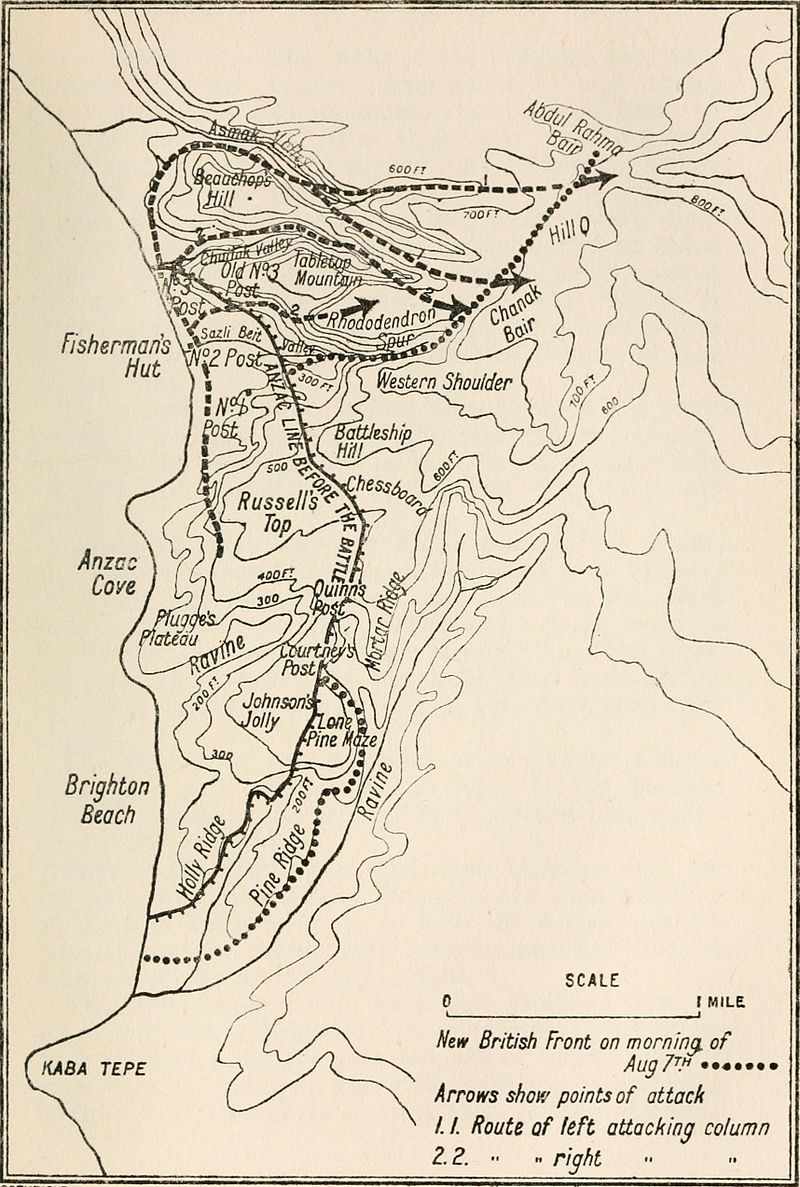
Two diversionary attacks were also planned; at Lone Pine, by Australian troops; and by the British at Cape Helles, at a location named Krithia Vineyard.
The Wellington Mounted Rifles succeeded in capturing Destroyer Ridge and Table Top on 6th August, and other units of the New Zealand Mounted Rifle Brigade also achieved their objectives, though with heavier casualties.
The Left Assaulting Column, however, failed to reach its objective of Hill Q and Hill 971.
Had the landing at Suvla Bay been followed up by a swift advance, Ottoman troops would most probably have been diverted from the Anzac front, potentially assisting in the success of the Anzac attack on the Sari Bair range. However, the Suvla Bay landings made little progress, and were not followed up with any rapid advance.
On 8th August, the attack was renewed. The forces targeting the Sair Bair range were rearranged into three columns.
The Wellington Mounted Rifles were in the first column, apart from the 9th Squadron which was left to hold Table Top. The first column was ordered to hold and consolidate the ground gained on the southwestern slopes of Chunuk Bair, and, if possible, gain the whole of the Chunuk Bair position and extend as far as they could southwards and eastwards. The WMR occupied "the central position of the Chunuk Bair trenches - the cockpit of the whole position - at 10.30pm. These trenches were fifteen yards from the crest, held by the enemy, the latter's trench being ten yards further back". Although the trenches were difficult to defend from bombs lobbed from the Ottoman lines, "the crest of the ridge was a death-trap for either side to appear on". The WMR were thus able to hold the position against intense attack, but at an extremely heavy cost. Eventually they were relieved at 10.30pm the following day, 112 officers, NCOs and men having been killed or wounded - well over 60% of the numbers involved (figures from the Official Regimental History).
Elsewhere, the second column briefly reached the top of the ridge at Hill Q, but was forced to withdraw, not least because naval gunfire aimed against Ottoman forces made the position extremely dangerous. In the meantime, the third column had lost its way in negotiating the very difficult country during the night, and so was unable to assist at the peak of the Ottoman attack, though they were able to reach a position a little way below the top of Chunuk Bair, a little while later.
However, on 10th August, Ottoman forces counter-attacked (led by Mustafa Kemal Ataturk, later the first President of Turkey), and regained control of the Sari Bair ridge. The forces landed at Suvla Bay also faced a strong and effective Ottoman defence and failed to make progress.
Australian forces successfully (though at huge cost) took the Ottoman position at Lone Pine, but failed in their diversionary purpose - Ottoman forces were diverted from Cape Helles, rather than from the main Anzac assault. The British assault at Krithia Vineyard also failed to meet its diversionary purpose. Ottoman trenches were taken, but were then lost again.
On 16th August, when Percy's service papers record him rejoining his unit, the Wellington Mounted Rifles were in reserve at Sazli Beit Dere (Valley). The 9th Squadron continued to hold Table Top, the position they had won ten days earlier. Percy was presumably one of the 35 reinforcements who joined the regiment that day, according to the Unit's War Diary. Total numbers were 13 officers and 253 men.
The position remained the same until the regiment was called into the Battle of Hill 60, which was part of the final stage of the August Offensive.
Death
The Battle of Hill 60 was launched on 21st August to coincide with an attack on Scimitar Hill at Suvla. Hill 60 was a low hill at the northern end of the Sari Bair range, bordering the Suvla landing. The aim was to attempt to link up the Suvla landing position with the Anzac position.
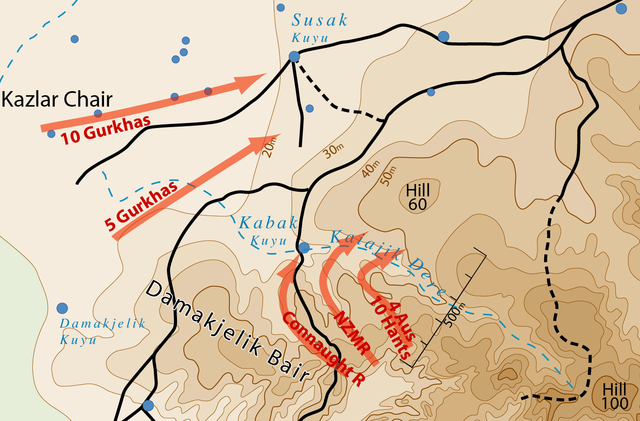
The position was held by the Ottomans. A mixed force of New Zealand, Australian, Gurkha and British soldiers attacked. Although the New Zealand Mounted Rifle Brigade was part of the initial attacking force, the Wellington Mounted Rifles were not involved to begin with, due to the heavy casualties they had sustained earlier in August. However, a further three officers and 77 other ranks had arrived on 23rd August from New Zealand, via Egypt, to reinforce numbers, making the regiment's strength 15 officers and 284 other ranks. The Wellingtons rejoined the Brigade that day, when five officers and 125 other ranks relieved the Canterbury Mounted Rifles in trenches gained on the western slopes of Hill 60, and held the position for two days.
On 25th August preparations were made for a further attack on the summit of Hill 60, involving a force of 850 men:
- On the right: 300 Australian Infantry
- In the centre: 300 men from the New Zealand Mounted Rifles, including five officers and 100 other ranks from the Wellingtons, and 100 Australian Infantry
- On the left: 250 Connaught Rangers
The Centre Force was to attack in three lines - the first, 160 men from the Auckland and Canterbury Mounted Rifles; the second, the Wellington and Otago Mounted Rifles; the third line, comprising the Australians, in reserve.
The first line was ordered to capture the first enemy trench, the second line to follow on, jump over the first trench, and capture the second. Presumably, Percy was in the second line.
After an hour's bombardment, according to the Regimental History, at 5pm:
The attack commenced, the two lines of the Centre Force dashing "over the top" with great vigour ... Intense rifle and machine-gun fire was immediately encountered, for notwithstanding the effect of the bombardment, the enemy trenches were fully manned, and our men met with very strong opposition. The intervening ground was much exposed, the casualties in consequence being very heavy .... [but] immediately our front-line men reached the first enemy trench they sprang into it and quickly proved their superiority with the bayonet ... the second line continuing its advance whilst their comrades completed the destruction of the enemy in the first trench.
Meanwhile the Turkish gunners had ranged on the Centre Force, and their deadly shrapnel reinforced the fusillade of rifle and machine gun fire, which continued to concentrate on the advancing line. The casualties of the latter steadily increased, but ... the survivors ... pressed forward most resolutely .... With increasing boldness and desperate determination, the New Zealanders bombed and bayoneted [the enemy] and captured the second trench.
By this time, however, numbers in the Centre Force were few. The advance had been held up on the right and "some time later" the Connaughts withdrew from the position they had taken on the left. The Centre Force were thus in a "precarious position in a narrow salient" and further advance was stopped while the position that had been reached was consolidated. Reinforcements arrived at 10pm.
Wellington Mounted Rifle casualties were two officers killed and five wounded; and 48 other ranks killed and 54 wounded. One of those killed was Percy, in his first and last battle with his regiment. Another was Alf Iggulden, his boxing friend.
During the night the remainder of the Regiment moved into the trenches to support those already there, and the work of strengthening the position continued. A further attack was successful in linking up both trenches which had been captured the day before, and those trenches were held until the evacuation of the peninsula. But, though a part of Hill 60 had been taken, the whole of the crest was not gained.
Killed on 28th August, the day after Percy, was Chaplain Major William Grant, who had played a key part in producing the "Orari Tatler". He was killed when attempting to attend a wounded man who had fallen beyond a barricade which had been erected in the trench against the Ottoman position. The ground was covered with bodies, and, according to the Regimental History, Major Grant remarked to another clergyman "We are now most assuredly in the Valley of the Shadow of Death" and was killed immediately afterwards.
On 29th August the New Zealanders were relieved from the trenches, but remained in close proximity to Hill 60, in reserve. On 12th September they were withdrawn from Gallipoli to the island of Lemnos for rest. According to the Regimental History, of those who had originally landed on Gallipoli four months earlier, only 24 were left.
Commemoration
On 23rd September 1915 the following appeared "The Star" newspaper in New Zealand:
Killed in the Dardanelles
Trooper Percy Turner, only son of Mr F C Turner, Mayor of Eketahuna, has been killed at the Dardanelles. Deceased was a member of the first New Zealand force, and, though invalided for some time in Egypt, refused to consider a proposal that he should return to New Zealand. He was only thirty years of age, and was educated at Wellington College.
(He was in fact 25).
News reached Dartmouth almost as quickly. On 24th September 1915 the following appeared in the Dartmouth Chronicle:
New Zealand Trooper killed in action
Official information was last night received by Mr H M Turner, Derwent Lodge Dartmouth, that his nephew, Trooper Percy Edward Turner, Wellington Mounted Rifle Regiment, New Zealand Force, was killed in action in Gallipoli on August 27th. The late Trooper P E Turner was the son of Mr Francis C Turner, who has resided for many years in New Zealand.
Percy Edward Turnor is buried close to where he fell, in Hill 60 Cemetery on the Gallipoli peninsula.
He is commemorated on the Eketahuna War Memorial and on his father's gravestone in the Mangarongo Cemetery, Eketahuna. He is also commemorated in the Hall of Memories at the New Zealand National War Memorial in Wellington.
In 1919 Wellington College published a special edition of its magazine commemorating the service in war of its Old Boys. Pictures appeared of many of those killed in action, including Percy:
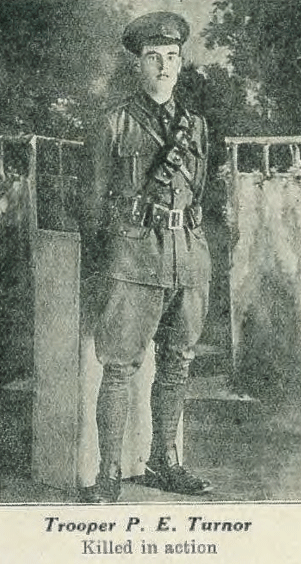
Note:
The family name was spelt "Turnor". However, many official records and other sources such as newspapers spell the name incorrectly as "Turner". In this article, where sources are quoted directly, the original spelling has been retained, even where incorrect.
Sources
Museum of New Zealand: The Settling of Eketahuna
The 1897 Cyclopedia of New Zealand: Entry on Eketahuna
Heritage New Zealand: Listing of Wiwaka Station
The Penguin History of New Zealand, by Michael King, publ Penguin Group (NZ), 2007
The New Zealand Expeditionary Force
Auckland War Memorial Museum: editions of the Orari Tatler accessible online
War Diary of the Wellington Mounted Rifles
Official War History of the Wellington Mounted Rifles Regiment 1914-1919, by A H Wilkie, publ Whitcombe and Tombs Ltd, 1924, available online
Archives New Zealand, Percy Edward Turnor 11/388 Service papers, record number R22014389, digitised images available on line, no charge
Auckland War Memorial Museum: Online Cenotaph
Wellingtonian 1919: A Record of Wellington College Old Boys who fought in the Great War
Information Held on Database
| Surname: | Turnor |
| Forenames: | Percy Edward |
| Rank: | Trooper |
| Service Number: | 11/388 |
| Military Unit: | Wellington Mounted Rifle Regiment, New Zealand Expeditionary Force |
| Date of Death: | 27 Aug 1915 |
| Age at Death: | 25 |
| Cause of Death: | Killed in Action |
| Action Resulting in Death: | Battle of Hill 60, Gallipoli |
| Place of Death: | Gallipoli |
| Place of Burial: | Hill 60 Cemetery, Gallipoli |
| Born or Lived in Dartmouth? | No |
| On Dartmouth War Memorial? | No |
| On St Saviour's Memorials? | No |
| On St Petrox Memorials? | No |
| On Flavel Church Memorials? | No |
| In Longcross Cemetery? | No |
| In St Clement's Churchyard? | No |
| On a Private Memorial? | Yes |
| Name of Private Memorial: | Father's Gravestone, Mangarongo Cemetery, Eketahuna |
| On Another Memorial? | Yes |
| Name of Other Memorial: | Obituary in Dartmouth Chronicle, Eketahuna War Memorial, New Zealand, and New Zealand National War Memorial, Wellington |















